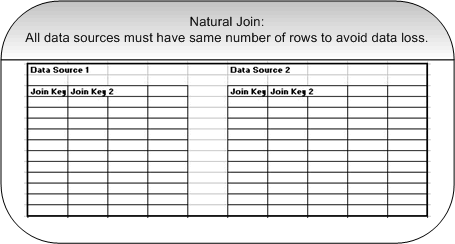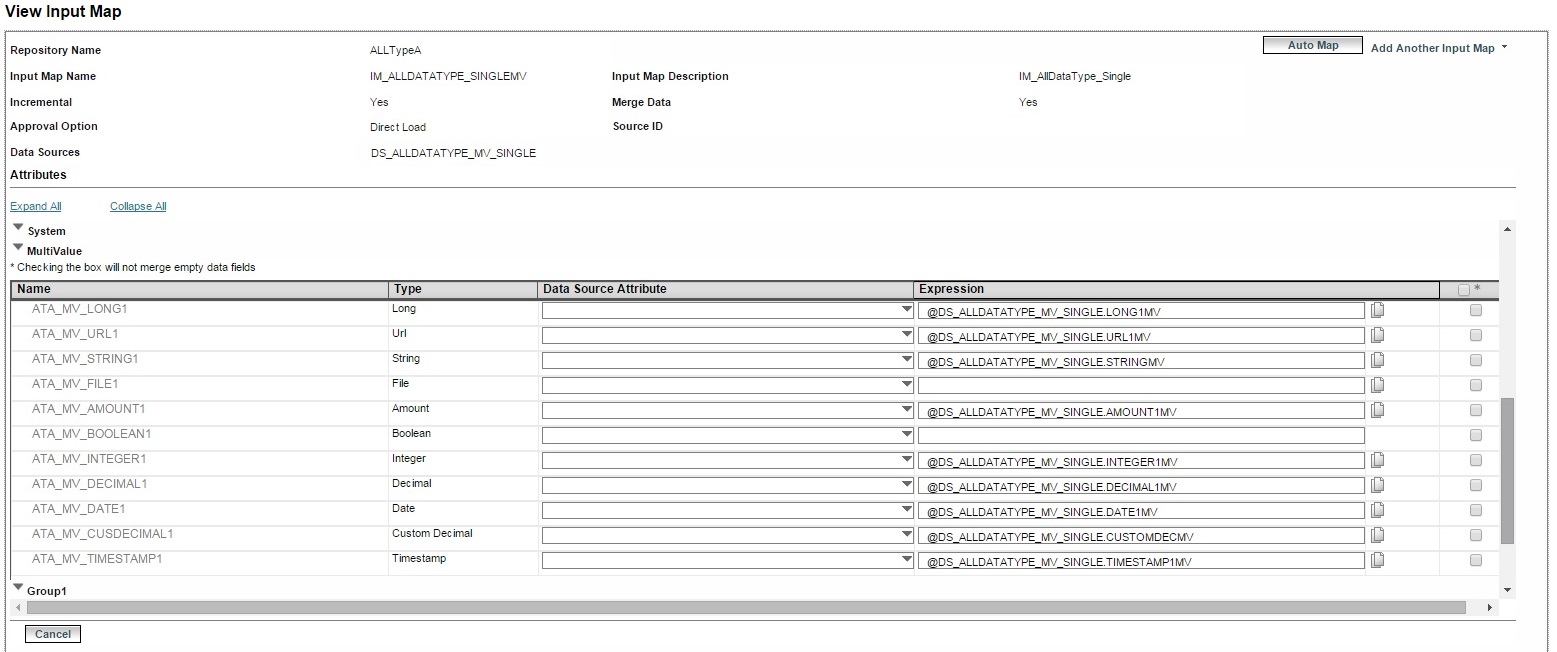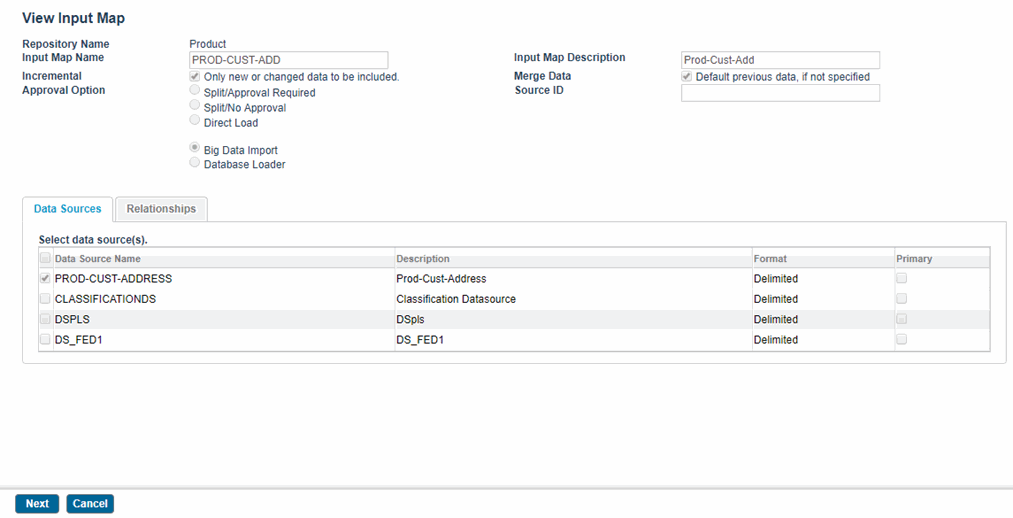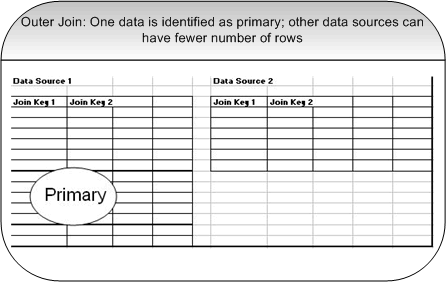Viewing Input Maps
To view details of an input map, select the input map name on the Input Map page and click
 . The View Input Map page is displayed.
. The View Input Map page is displayed.
The View Input Map page contains the following sections:
- Input Map Details: The name and description for the Input Map. The Name is unique and not case-sensitive for a repository. The name can contain A-Z, 0-9, and _.
- Approval Option: See Approval Options.
- Source ID: The source ID allows you to associate the data with an external system. The source ID is not automatically stored with records as attributes, but a rulebase can be used to copy the value to an attribute. The source ID can be used in workflow and business process rules to customize business processes.
- Merge Data : Select to retain the previous child relationships. When you select this check box, any null values in the imported data are populated with data already stored in the database, provided the nullIfblanks input mapping option is not selected for such attributes. This allows partial data to be imported.
- The
Data Sources tab: If you have selected more than one data source to map to an input map, the next page displays a set of keys that are common to the selected data sources. The key columns of each datasource has the same name in all joined data sources. If the selected data sources do not include common keys, the following error message is displayed:
Invalid Input map; no common key defined.
You can identify one of the datasource as the primary data source by the Primary? check box in the appropriate data source row.
Note: If you do not select primary datasource, a row is discarded. The data corresponding to keys is not present in all the joined data sources.Primary data source identification is optional. It is recommended only if multiple data sources or a data source has fewer number of rows, and join key for such rows in primary data source do not exist in other data source. The primary data source should be the one which is a pivot data source. When multiple data sources are selected, data between the data sources is joined as follows:
- Outer Join: If a primary data source is identified, data from other data sources is joined with the primary data source using an outer join.
- Natural Join: A natural join is also known as an equi-join. If no primary data source is identified, data from all data sources is joined using a natural or equi-join. To avoid loss of data, all data sources must have the same set of records.

- Attribute Mapping: The View Input Map page displays an Attribute Mapping section to map data source attributes to the repository attributes. From this page, you can view selected attributes from a data source to import to a repository. The data source attributes are mapped to the repository attributes.
- Click Expand All to view the user-defined system attributes and the user-defined attributes in their respective Attribute Groups.
- Click
Collapse All to collapse the Attribute Group list. In this case, only the names of the Attribute Groups are displayed.
Click
 next to an attribute group to display or hide its attributes.
next to an attribute group to display or hide its attributes.
The Data Source Attribute list displays all the columns available in the selected data source or sources. When you select an attribute, the mapping automatically appears in the Expression column. The following figure shows mappings of a multivalue attribute:

Multivalue attributes can be mapped to different attributes of a data source. For multivalue attributes, you can click
 to add one more row. A new row is added to the table where you can map the data source attribute to a repository attribute which was cloned. You can click
to add one more row. A new row is added to the table where you can map the data source attribute to a repository attribute which was cloned. You can click
 to delete the mapping row.
to delete the mapping row.
- Relationship attributes are listed under the Relationship Attributes group. source.

- Expression: Enter a valid SQL expression in the
Expression
column. The expression must conform to following rules:
- All expressions entered in the Expression column must be valid SQL expressions.
- If you include a column name from an SQL table, ensure that the name entered exists and is as specified in the SQL table.
- Enter integers directly, but embed String values in single quotation marks.
- If data contains an @ character, it cannot be entered in the source expression.
The following are a few sample SQL expressions:
CASE WHEN ((@<Data Source Name>.UOM) = '') THEN (SUBSTR('CONSTANT',1,4)) ELSE (SUBSTR('CORRECTEDPACK',1,13)) END CASE WHEN ((@FLAG.FLAG) = 'm') THEN @FLAG.DESC ELSE (SUBSTR('',0,0)) END
- Check box with an asterisk: Appears to the left of the Attribute Name for all required attributes in a given format.
Select the check box in the * column if you want to consider a blank value in the data source as NULL. Usually, this flag is specified for CONTAINS attribute. It is used only if Merge Previous Data is TRUE and CONTAINS attribute does not have any value for the record. When the check box in the * column is selected, it indicates that child relationships would not be merged if no value is specified in the CONTAINS attribute. For more information on Contains attribute, see Explicit Relationship Using the CONTAINS Attribute.
- Automatic mapping: If the data source attribute name and the repository attribute name are the same, click
Auto Map to automatically map the attributes. Any attribute which does not have a mapping (null) is mapped if the name of the attribute matches the attribute name in the data source.
If multiple data sources with the same attribute name exist, and Primary is specified, the primary data source is given priority. If Primary is not specified, the data source is picked up randomly.
- Automatic mapping: If the data source attribute name and the repository attribute name are the same, click
Auto Map to automatically map the attributes. Any attribute which does not have a mapping (null) is mapped if the name of the attribute matches the attribute name in the data source.


